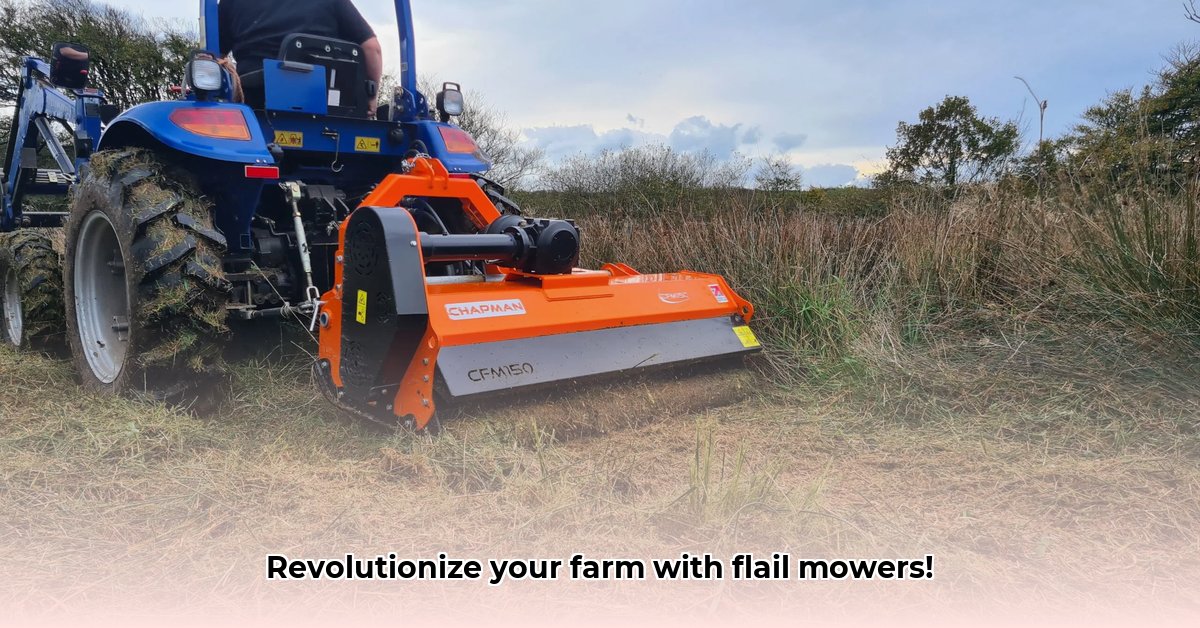
Flail Mower for Tractor: Boosting Farm Efficiency and Sustainability
Balancing farm efficiency with environmental responsibility is crucial. Tractor flail mowers offer a practical solution, significantly impacting land management practices. This article explores their benefits, challenges, and best practices for sustainable use. For more on tractor implements, check out this helpful resource on tractor PTO tillers.
Efficiency Gains with a Tractor Flail Mower
Manual mowing is time-consuming and labor-intensive. A tractor flail mower dramatically reduces mowing time, freeing up resources for other farm tasks. This translates to potential cost savings and increased farm productivity. The fine chopping action also accelerates the decomposition of plant matter, potentially reducing the need for chemical fertilizers – a win for both your budget and the environment. Isn't this a more efficient and effective way to manage your land?
Lower Maintenance and Repair Costs
Unlike some mowing equipment, flail mowers typically use individual, replaceable cutting elements (flails). This targeted repair approach minimizes waste and reduces overall maintenance expenses. It's a more financially sustainable solution in the long run.
Enhancing Soil Health: A Natural Approach
The finely shredded plant material acts as a natural soil conditioner, enriching the soil structure and promoting microbial activity. This leads to healthier plants and potentially reduces the need for synthetic fertilizers, promoting healthier, more sustainable farming practices.
The Investment Factor: Is it Worth the Price?
While the initial investment can seem significant, the long-term benefits – reduced labor costs, lower maintenance, and potential fertilizer savings – often outweigh the initial expense. It’s a strategic investment in your farm's future productivity and sustainability. What are the long-term financial implications for your operation?
Environmental Aspects of Flail Mowing
While fuel consumption and noise are factors to consider, newer models showcase improved fuel efficiency and quieter operation. Proper maintenance and efficient mowing routes further minimize the environmental impact. How can you minimize the environmental footprint of your flail mower?
Choosing the Right Flail Mower for Your Farm
The type of flail (hammer or Y-flail) significantly impacts performance. Hammer flails excel in tougher vegetation, while Y-flails provide finer cuts. Selecting the right flail mower depends on your specific needs and vegetation types. Consulting with agricultural equipment experts is highly recommended to ensure optimal performance.
Steps to Sustainable Mowing with a Flail Mower
- Assess Your Needs: Evaluate your farm’s size, vegetation, budget, and mowing frequency before purchasing.
- Explore Financing Options: Consider loans or government grants for sustainable agricultural practices.
- Prioritize Preventative Maintenance: Regular maintenance is key to extending lifespan and improving fuel efficiency.
- Optimize Your Mowing Routes: Efficient routes minimize fuel consumption and wear and tear.
- Mitigate Noise Pollution: Mow during off-peak hours to reduce noise disruption.
A Quick Look at Potential Risks
| Risk Category | Likelihood | Impact | Mitigation |
|---|---|---|---|
| High Initial Investment | Medium | Medium | Secure financing; explore used equipment options; consider leasing. |
| Fuel Consumption | Medium | Medium | Optimize mowing routes; use fuel-efficient equipment; regular maintenance. |
| Noise Pollution | Medium | Low | Use quieter models; mow during less sensitive times; consider sound barriers if necessary. |
| Mechanical Breakdown | Low | Medium | Regular maintenance; prompt repairs; have a backup plan. |
| Incorrect Flail Choice | Medium | Low | Thorough research; consult with experts before buying. |
Keeping Up with the Latest Developments
Stay informed about noise and emission regulations and government incentives for sustainable farming practices. The agricultural landscape is constantly evolving, requiring ongoing research and adaptation to stay competitive and environmentally responsible.
How to Mitigate Noise Pollution from Tractor Flail Mowers
Key Takeaways:
- Sharp Blades Reduce Noise: Dull blades increase noise and reduce efficiency. Regular sharpening is crucial.
- Preventative Maintenance is Key: Addressing issues early prevents escalating problems and noise.
- Optimize Operating Parameters: The right balance of ground and PTO speed minimizes noise.
Keeping Your Flail Mower Sharp: The Key to Quieter Operation
Dull blades increase vibration and noise. Regular sharpening is essential. Sharpening can be done in place (with appropriate safety precautions) or by removing blades for individual sharpening. Always re-balance blades after sharpening to prevent further vibrations and noise.
Beyond the Blades: Addressing Other Noise Sources
Worn bearings and damaged belts contribute significantly to noise. Regular inspections should identify these issues early. A whining, squealing, or grinding sound indicates a maintenance need. Replacing worn parts is often a cost-effective way to reduce noise and extend machine lifespan.
Optimizing Operating Parameters for Noise Reduction
Experiment with ground speed and PTO speed to find the optimal balance between efficiency and quiet operation. The optimum settings depend on terrain and grass conditions.
Preventative Maintenance: The Best Noise Reduction Strategy
Regular maintenance, including inspections of blades, belts, bearings, and other components, is crucial for minimizing noise and maximizing equipment lifespan.
A Simple Maintenance Schedule
- Monthly: Inspect blades, belts, and listen for unusual noises.
- Annually: Lubricate moving parts and replace worn bearings. Consider professional inspection if needed.